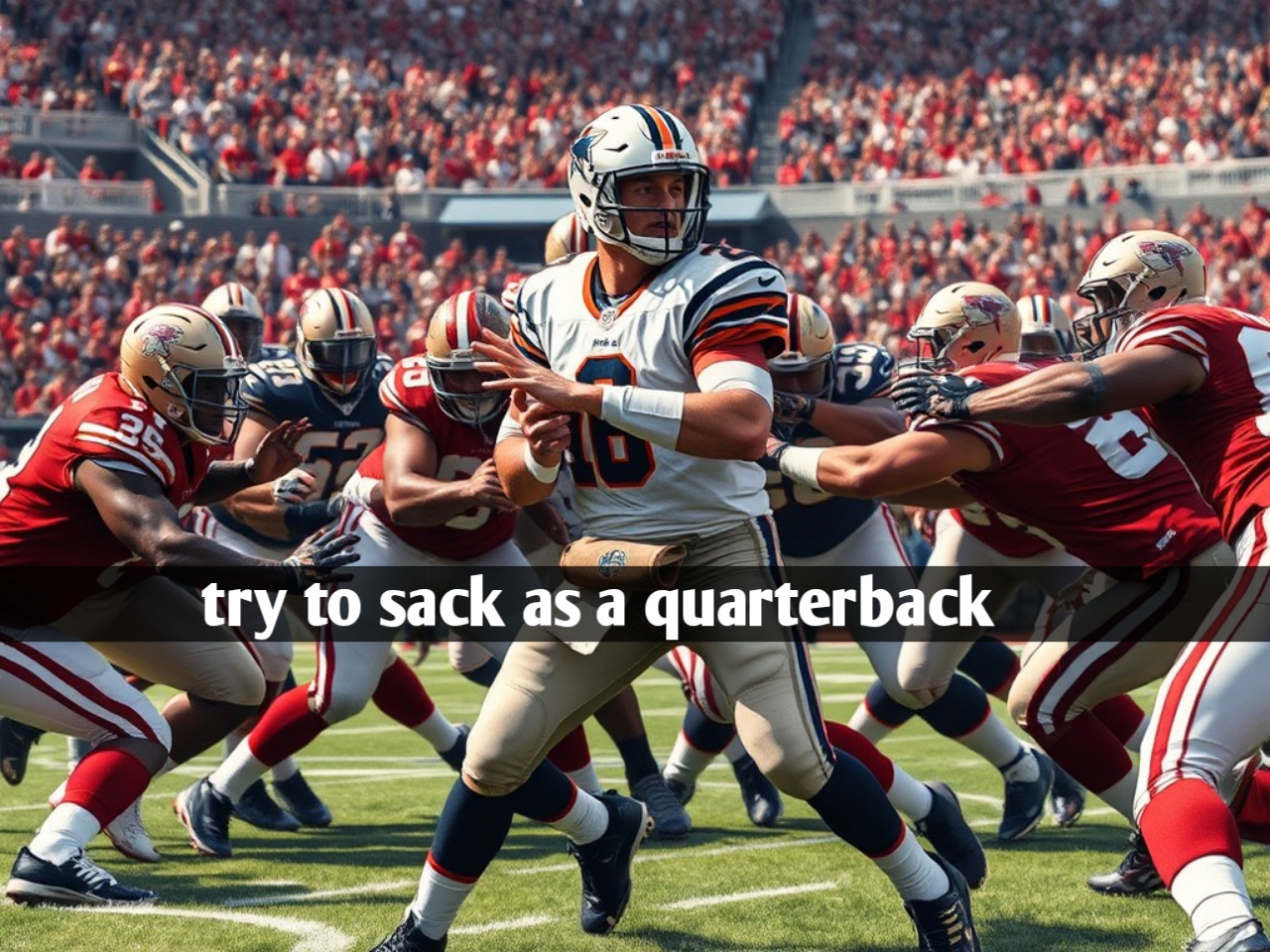How to Try to Sack as a Quarterback and Avoid Pressure
In football, few positions are as critical as the quarterback. They are the brain of the offense, responsible for making quick decisions, reading defenses, and leading the team downfield. But for a quarterback to succeed, they must survive relentless pressure from defenders trying to bring them down. Sacking the quarterback is one of the most impactful defensive plays, often resulting in lost yardage, potential turnovers, and disrupted momentum. For a quarterback, understanding how to avoid being sacked is crucial for survival in the fast-paced, high-pressure world of football.
This comprehensive guide will explore the techniques and strategies that quarterbacks can use to avoid sacks, maintain offensive rhythm, and improve overall game performance. From recognizing defensive schemes to mastering footwork and pocket awareness, we’ll cover everything you need to know to stay upright and keep your team moving forward.
Understanding What It Means to Sack a Quarterback
In football, a sack occurs when a defensive player tackles the quarterback behind the line of scrimmage while they still have the ball. The primary goal of the defense is to disrupt the offense’s passing game, and sacking the quarterback is one of the most effective ways to achieve that goal.
Sacks are devastating for offenses because they result in a loss of yardage and momentum. They force teams into longer down-and-distance situations, making it more challenging to convert on third or fourth downs. In some cases, a sack can also lead to a fumble, giving the defense a chance to recover the ball and potentially score points.
For quarterbacks, sacks can be physically punishing and mentally demoralizing. That’s why it’s vital for a quarterback to develop techniques that help avoid sacks altogether. By improving their awareness, agility, and decision-making, quarterbacks can reduce their chances of being sacked and stay in control of the game.
The Importance of Pocket Awareness for Quarterbacks
One of the most critical skills for avoiding sacks is pocket awareness. The “pocket” refers to the space created by the offensive linemen who block the defense to give the quarterback time to throw the ball. Ideally, the pocket provides a secure environment where the quarterback can survey the field and make an accurate pass. However, this protective space is often under siege as defenders try to collapse it from the outside and inside.
Great quarterbacks possess an innate sense of pocket awareness—they understand how much time they have before the pocket breaks down and know when to step up or move laterally to avoid the rush. They can feel the pressure without having to see it directly, and this instinct is developed through experience, film study, and practice.
To improve pocket awareness, quarterbacks need to:
- Read the defense pre-snap: This helps them anticipate where the pressure might come from.
- Keep their eyes downfield: Even as pressure builds, quarterbacks must maintain focus on potential receivers.
- Use subtle movements in the pocket: Stepping up or shifting sideways can buy extra time without leaving the pocket entirely.
- Trust their offensive line: Overreacting to pressure can result in premature scrambles or forced throws.
Effective pocket awareness enables quarterbacks to extend plays, avoid unnecessary hits, and deliver more accurate throws under duress.
How to Read Defensive Schemes and Anticipate Pressure
One of the most valuable tools a quarterback can have in their arsenal is the ability to read defensive schemes before the snap. The defense will often try to disguise their blitzes, coverages, and pressures to confuse the quarterback. However, with careful study and preparation, quarterbacks can learn to recognize patterns that indicate where pressure will come from.
Here are some key factors quarterbacks should watch for:
- Defensive alignment: How are the linebackers and defensive linemen positioned? Are there any players showing blitz? Are the safeties creeping toward the line of scrimmage?
- Down and distance: Certain situations are more likely to result in aggressive blitzes, such as third-and-long.
- Coverage schemes: Identifying whether the defense is in man or zone coverage can provide clues about how many defenders will be rushing versus dropping into coverage.
- Tendencies from film study: By watching film of upcoming opponents, quarterbacks can learn about specific defensive tendencies. Some defensive coordinators love to send certain blitzes in predictable situations.
By studying and recognizing these cues, quarterbacks can make pre-snap adjustments, such as calling for extra protection or changing the play to a quick throw. Anticipating where the pressure will come from can significantly reduce the chances of being sacked.
The Role of Footwork in Evading Defenders
Footwork is another crucial element in a quarterback’s ability to avoid sacks. Good footwork allows quarterbacks to navigate the pocket smoothly, set their feet for throws quickly, and escape pressure when necessary. Without proper footwork, even the most skilled quarterbacks can struggle to avoid defenders.
Effective footwork involves:
- Maintaining a balanced stance: Quarterbacks need to stay light on their feet, ready to move in any direction at a moment’s notice.
- Quick, short steps: When moving within the pocket, taking short steps helps quarterbacks remain stable and keep their throwing mechanics intact.
- Pivoting and spinning out of pressure: In certain situations, quarterbacks need to pivot or spin to evade defenders who have penetrated the pocket.
- Scrambling with control: When a quarterback decides to leave the pocket, they must do so with a plan—either to extend the play and find a receiver downfield or to gain positive yardage by running.
Good footwork isn’t just about athleticism; it’s about discipline and practice. Many quarterbacks spend countless hours working on drills that improve their footwork under pressure, helping them stay composed when the pocket collapses.
Quick Decision-Making: Knowing When to Throw It Away or Scramble
One of the most important aspects of avoiding sacks is knowing when to get rid of the ball. Holding onto the ball for too long is a common mistake among quarterbacks, especially those who are trying to make a big play. However, sometimes the best decision is to throw the ball away or scramble for a short gain rather than risk being sacked.
Here are a few key decision-making scenarios:
- Throwing the ball away: If the pocket collapses and no receivers are open, quarterbacks can legally throw the ball out of bounds, provided they are outside the tackle box. This prevents a sack and avoids negative yardage.
- Scrambling: When there’s a lane available, quarterbacks can use their athleticism to escape the pocket and pick up yards with their legs. Even a small gain is better than a sack.
- Checkdowns and short passes: If a quarterback reads pressure early, they can hit a running back or tight end on a short route, keeping the play alive and avoiding a sack.
Developing quick decision-making skills requires practice and film study. Elite quarterbacks can process information in seconds, scanning the field for open targets or escape routes before defenders reach them.
The Benefits of Offensive Line Communication and Adjustments
While much of the responsibility for avoiding sacks falls on the quarterback, the offensive line plays a critical role as well. A well-coordinated offensive line can protect the quarterback from even the most aggressive pass rushes. Communication between the quarterback and offensive line is essential to ensure everyone understands the protection schemes and potential blitz pickups.
Quarterbacks should:
- Communicate protections at the line of scrimmage: Before the snap, quarterbacks can identify potential blitzers and call for adjustments, such as sliding the protection or assigning a running back to block.
- Trust the offensive line: Sometimes, quarterbacks panic under pressure and abandon the pocket prematurely. Trusting the offensive line to handle the pressure can give quarterbacks more time to make the right play.
- Study the protection schemes: Quarterbacks need to understand the offensive line’s protection calls just as well as the linemen do. This ensures everyone is on the same page, reducing the risk of missed assignments.
A well-protected quarterback has more time to read the defense and make accurate throws, significantly reducing the chances of a sack.
How Mobility and Athleticism Help Quarterbacks Escape Sacks
In today’s NFL, mobility is becoming an increasingly important trait for quarterbacks. While traditional pocket passers still thrive, many of the league’s top quarterbacks are also skilled runners who can use their legs to escape pressure and extend plays.
Mobile quarterbacks like Patrick Mahomes, Lamar Jackson, and Josh Allen are prime examples of how athleticism can help avoid sacks. These players can:
- Evade defenders with quickness and agility: They are capable of outrunning defensive linemen or juking linebackers in open space.
- Turn broken plays into positive yardage: Even when the pocket collapses, mobile quarterbacks can scramble for first downs or make off-platform throws to open receivers.
- Keep defenses guessing: When a quarterback is a threat to run, defenses must account for that, which can limit their ability to send all-out blitzes.
Even quarterbacks who aren’t as naturally mobile can benefit from improving their agility and conditioning. Being able to move within the pocket and occasionally scramble can keep defenses honest and reduce the risk of being sacked.
Avoiding Mental Sacks: Staying Calm Under Pressure
The physical aspects of avoiding sacks are important, but the mental side of the game is equally critical. Quarterbacks must learn how to stay calm and composed under pressure, even when the defense is closing in fast. Panicking often leads to poor decisions, such as throwing into coverage or holding onto the ball too long.
Mental toughness can be developed through:
- Repetitive practice: The more a quarterback practices under simulated pressure, the more comfortable they will be in real game situations.
- Visualization techniques: Many quarterbacks use visualization to mentally prepare for pressure situations, imagining themselves making smart decisions and avoiding sacks.
- Short-term memory: Great quarterbacks can quickly forget about a previous hit or sack and focus on the next play. Dwelling on mistakes can lead to hesitation and more sacks.
Quarterbacks who stay calm under pressure are more likely to make smart decisions, avoiding unnecessary sacks and keeping the offense moving.
Conclusion: Mastering the Art of Dodging Sacks
Avoiding sacks as a quarterback requires a combination of physical skill, mental toughness, and a deep understanding of the game. By developing pocket awareness, improving footwork, reading defensive schemes, and communicating effectively with the offensive line, quarterbacks can significantly reduce their chances of being sacked. Additionally, quick decision-making and mobility are essential tools for staying upright in the face of relentless defensive pressure.
Ultimately, the ability to avoid sacks is one of the key traits that separates good quarterbacks from great ones. It allows them to extend plays, maintain offensive rhythm, and lead their teams to victory. Whether you’re a young quarterback learning the ropes or an experienced player looking to sharpen your skills, mastering these techniques will help you stay in the game and out of the grasp of defenders trying to bring you down.
read Also Our This Post: Why eTrueSports Tech is the Next Big Thing in Sports Science

Kamran Khatri is a versatile writer and editor at ExpressZone.co.uk, bringing fresh perspectives and insightful commentary across a wide range of topics. With a passion for exploring diverse subjects—from technology, business, and finance to lifestyle, travel, and the arts—Kamran aims to inform, inspire, and engage readers through well-researched articles and thought-provoking content.
His work spans multiple categories including health, education, pets, entertainment, real estate, and sustainability, reflecting his commitment to delivering knowledge that connects with everyday life. Whether breaking down the latest trends, sharing practical tips, or highlighting cultural insights, Kamran’s writing combines clarity with creativity.
When he’s not crafting stories for ExpressZone.co.uk, Kamran enjoys keeping up with global developments, exploring innovative ideas, and connecting with readers who share his curiosity about the world.






